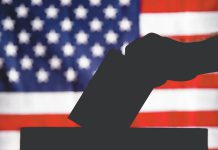By Eric Smith Gilroy High School
On Sept. 11, 2001 The United States was forever changed when, for the first time on U.S. soil, the nation came under attack, ultimately resulting in nearly 3,000 lives lost. Now over three years later, we look back at that fateful Tuesday and the events that followed.
By Eric Smith Gilroy High School
On Sept. 11, 2001 The United States was forever changed when, for the first time on U.S. soil, the nation came under attack, ultimately resulting in nearly 3,000 lives lost. Now over three years later, we look back at that fateful Tuesday and the events that followed.
“I remember thinking, ‘How could someone do something like this?’ and, ‘How inhuman the attacks were,'” said Michelle Coffin, 14, a 9th grader at Gilroy High School.
By noon on 9-11 the landscape of our country had been horrifically reconfigured. The end results of four hijacked commercial airliners were the ruins of the Twin Towers and a badly damaged Pentagon, the home of the U.S. Department of Defense.
The fourth hijacked airliner, which failed to connect with its projected target, went down in an open field in Pennsylvania. All passengers on board the doomed airliners perished in the events that unfolded that September day.
The tragedies that took place on 9-11 were unprecedented and left some feeling very uneasy.
In the months following 9-11, the U.S. government, acting on leads and intelligence received, declared war on Afghanistan in retaliation for the terrorist attacks. The U.S. believed that the Taliban, which was the established government of Afghanistan, was harboring Osama Bin Laden and his extremist group, al-Qaeda. They were believed to be the group responsible for orchestrating the terrorist attacks against the United States.
The war in Afghanistan ended quickly, but the U.S. failed to bring down al-Qaeda entirely or its leader, Bin Laden. Finding little to be done in Afghanistan, the U.S. decided to shift its war focus to the “War on Terror” at home.
“I support the war, but then again, I don’t,” said Andrew Holm, a 17-year-old Live Oak High School graduate. “I’m kind of in the middle when it comes to the war.”
The U.S. decided to take a new plan of attack against terrorism at home after 9-11. The formation of the Department of Homeland Security, which is headed by former Pennsylvania Governor Tom Ridge, aided the effort by analyzing and assessing “possible terror risks” within the U.S. The Department of Homeland Security also offers “terror alerts” which inform the government, as well as the general public, about the current safety of the U.S. from potential attacks.
New laws such as the Patriot Act, which limit some of our freedoms to ultimately increase our safety, were passed in the aftermath of 9-11 with little to no debate in Congress. As the United States began to feel comfortable again with safety measures taken home, the government began to cast its eyes on Iraq.
President George W. Bush, on the eve of what would be the march towards a second US-Iraq conflict, informed America of this new effort to stop any possible threats against the homeland. In this address, Bush said the objective of the war was “to disarm Iraq, to free its people and to defend the world from grave danger.”
On March 19, 2003 the U.S. launched its war on Iraq with a “shock and awe” bombing campaign on Baghdad,the capital, and other selected targets throughout the country. In just a few weeks from the beginning of the campaign, U.S. ground troops had already reached Baghdad, with minimal resistance.
Several months later, Saddam Hussein, the former dictator of Iraq, was captured. The U.S. had taken full control of Iraq. By the week of June 27, 2004 the U.S. had selected a new committee to lead Iraq and had handed over control to these select few.
“I believe the war effort was somewhat necessary because [the United States] helped out Iraq and captured their leader. I just don’t like it because of all the people that have died,” said Katelin Faria, 13, a 9th grader at Gilroy High School.
On Sept. 11, 2001 the United States and its principles came under attack. Three long years later, we still stand together as one nation, even after all we have been through.














